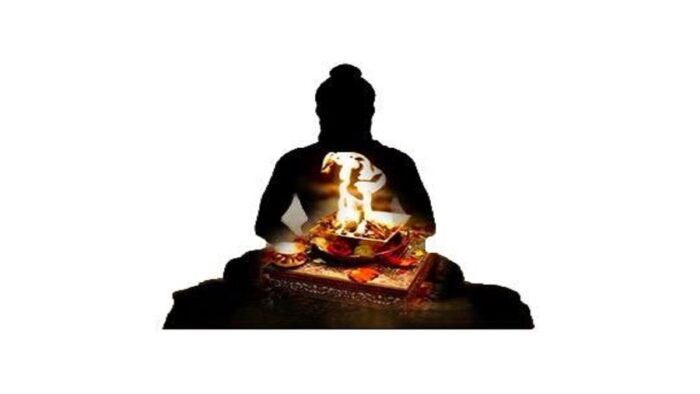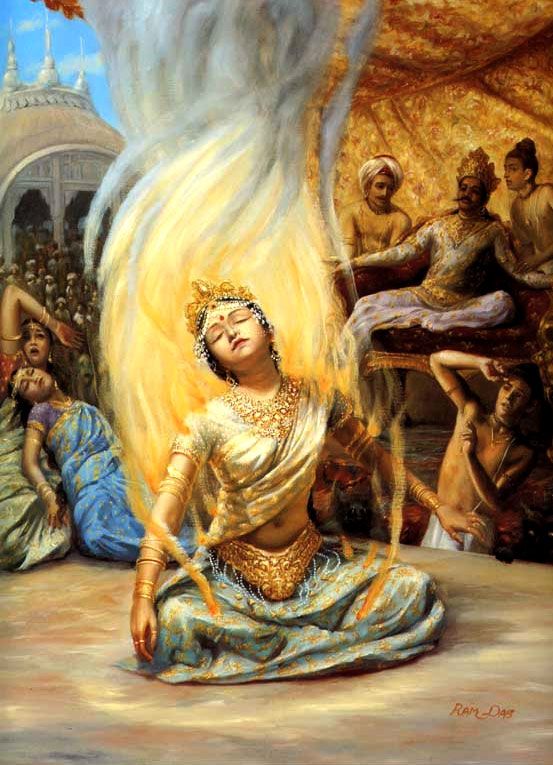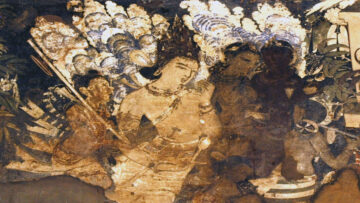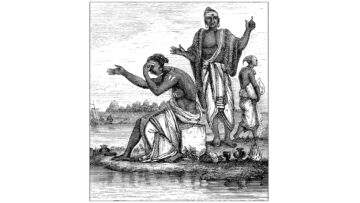This is the fourth in a series of articles about rituals. Click here for Part 1, Part 2 and Part 3.
Introduction
The previous part of this two part article explored the Christian theological roots behind the commonly accepted idea of rituals as expressions of beliefs and goals. This idea is often the underlying assumption behind criticisms of rituals as superstitions, as well as attempts to ground rituals in sound reasons and beliefs.
As mentioned in the previous part of this article, currently, we have little research and theorizing about what rituals are, what we can learn from them, the role they play in structuring Indian culture. The goal of this article is to raise questions and problems for future research, based on whatever little research has been done on rituals, primarily concentrating on the research of scholars S.N. Balagangadhara, J.C. Heesterman, and Frits Staal.
This second part of the article ”Why Rituals? Why Today?” focuses on research problems and questions about how ritual as a learning process generates a psychology of the self. The first section of the article titled ”Rituals, Self, and Ethics”, will pose questions about how ritual as a learning process structures the everyday Indian folk psychology, specifically, the psychology of the self. It will also pose questions about how this psychology of the self shapes the Indian notion of dharma. The next section, titled ”Rituals and Vedanta” raises questions about the relationship, if any, between rituals and the adhyatmic traditions that are collectively called Vedanta.
Rituals, self, and ethics
Within Professor Balagangadhara’s hypothesis about cultural differences, there are learning processes that are shared across cultures. For example, the kind of learning processes that are used to build societies and groups, as well as the kind used to develop theories. These processes of learning also involve a meta learning: a learning to learn. It is this meta learning that configures and generates other learning processes, and structures the way we go about in the world. In such a configuration, one form of learning is dominant and the others are subordinate. Balagangadhara’s hypothesis shows one possible way of differentiating cultures, as configurations of learning. The Indian culture is one such configuration of learning in which practical or performative knowledge dominates. Practical knowledge has the social environment of a culture as its arena. As a result, practical or performative knowledge will have to do with building and sustaining societies.
In a culture where performative knowledge dominates other learning processes, the entity that generates its configuration of learning must itself be a structured set of actions. Moreover, these structured set of actions must be actions in its purest form. That is to say, actions that are not based on beliefs or goals. Balagangadhara proposes that ritual is that entity that generates the Indian configuration of learning. Since ritual structures the way Indians go about, the entire social process would look ritualized. We as Indians intuitively know this to be the case: from the way we entertain guests, to important life events (birth of a child, puberty, marriage), rituals are inextricably tied to our daily lives. Furthermore, if performative knowledge is about building and sustaining societies, then rituals must generate a way of learning that allows us to do so.
If ritual is indeed the meta learning process which gives rise to Indian culture and society, this opens up a plethora of research problems and questions in multiple fields and domains of research. For example, Professor Balagangadhara claims that since rituals have a recursive structure, the social arena that emerges from such a meta learning process, must itself exhibit the property of recursiveness. What does it mean to say that the social arena of a culture has a recursive structure? How does recursivity manifest itself in the social arena? How does ritual as a meta learning process build and sustain Indian society? Answering such questions would entail multigenerational interdisciplinary research in various fields from mathematics to linguistics to sociology. It would also involve studying the different social units of Indian society such as jati/kula/kudumba and how they are constituted by ritual practices.
According to Balagangadhara, rituals also structure the way individual Indians experience their goings about as well as the goings about of others around them. In other words, rituals generate a culture specific way of looking at human psychology. Since rituals are actions in their purest form, and not based on beliefs or goals, then a culture that is structured by rituals would view human actions as agentless. The Western conception of each human being as a unique person or self would be absent in Indian culture. A number of psychologists and anthropologists have noticed the absence of the Western concept of an autonomous, bounded self-existing free of society is alien to Indian culture.
Instead, what we find in Indian folk psychology is an identification between actions and persons. The self of a human being is nothing more than the sum of his or her actions. It is important to note that an individual’s action is meaningless outside of a relational context with others. That is to say, the nature and meaning of an individual’s actions depends very much on how others interpret them. It is others around us that construct our self, just as we construct the selves of others. For example, beating on a nail with a hammer is in itself meaningless. On the other hand, when the individual performing the action is a construction worker helping to construct a building, because a manager within a company hired him to do the job, then the action of hammering a nail acquires meaning because of the social context. It is the presence of the other (the manager and the organization) that gives meaning to the action of hammering the nail, and gives the individual hammering the nail his ‘identity’ as a construction worker. Similarly, one is a father, a mother, a daughter, and a friend, only to the extent that they are so recognized by others. To be recognized as such, one has to perform actions that are appropriate to the role of a father, mother, friend etc. Thus, one’s role and membership in different social groups (jati, gotra, parampara) become critical in constructing one’s self in the Indian social context. It is the sum of an individual’s roles as well as the actions performed within those roles that constitute his or her self.
An important question that arises pertaining to the link between rituals and the Indian notion of self: What part does ritual play in not only constituting these social groups, but also an individual’s role within these groups? This question is complicated by the fact that we know that each jati has its own set of rituals and practices that differentiates it from other jatis. At the same time, there is no defined set of rituals that ‘make’ a particular jati. We observe that members of a jati can abandon one or more of their traditional rituals, and still be considered part of that jati.
It is the concept of role appropriate action that becomes the basis for both the Indian psychology of the self as well as Indian ethics or dharma. Whether an action is appropriate or inappropriate is entirely context dependent. For example, Rama is considered to have behaved in accordance with dharma by obeying his father, whereas Prahalada is also considered to have behaved in accordance with dharma for disobeying his father.
As for the question of the relationship between ritual and dharma, in texts such as the Dharmasutras and Dharmasastras, ritual is equated with dharma. As Patrick Olivelle explains in his translation of the Dharmasutras:
”As karma is primarily ritual action, so dharmas are the rules of correct ritual procedure. As the semantics of karma widened to include moral/immoral actions, so dharma came to include norms of correct behaviour within both the ritual and the moral/social spheres. These two spheres of activity appear to be poles apart to the modern mind; it was not so to the traditional Indian mind. The ritual, the moral, and the social constituted a continuum. In the Dharmasutras we see the one overlapping the other and the authors passing from the one to the other imperceptibly. Some actions that may appear to us as sins and others that seem to be merely ritual infractions are often treated together.” (Olivelle, 1999, p. XXXVIII)
Another feature of dharma is its enormous complexity. One must learn how to act appropriately within a myriad of different roles and situations. The Indian traditions also claim that the highest form of dharma is one in which simply acts without desiring for the fruits of the action. The Bhagavad Gita says that the highest mode of activity is one in which acts are performed as usual, but the fruit (phala) of action (karman) is always renounced (karma-phala-tyaga). This kind of detached action becomes moral across different contexts. Rituals seem to be the perfect exemplar of this kind of action. As mentioned in my previous article, during the performance of the Vedic rituals, the fruits of the ritual are abandoned or renounced. Moreover, the concept of appropriateness is important to rituals as well. The Srauta Sutras detail the appropriate time and place for the performance of each of the Vedic rituals. The purohits involved in the performance of these rituals are specialists, and there are strict rules outlining which priest can perform which part of the ritual. For example, the Hotr is a priest of the Rgveda and is responsible for all recitations. The Adhvaryu is a priest of the Yajurveda and is responsible for all sacrificial actions. Given these properties, do rituals function as a prototype of dharma? Does the performance of rituals socialize us to learn to act ethically, the same way puranas and itihasas do? If yes, how does it do so?
Ritual and Vedanta
(Figure 1: Credit: Ram Das, ISKCON – Atmayagna: Self-sacrifice)
This following section will ask questions about the relationship between rituals and adhyatmic knowledge, with a particular focus on the traditions collectively known as Vedanta. Vedanta is often translated as the ‘end of the Vedas’, but it is better translated as the crown or culmination of the karma kanda (the ritual portion of the Vedas) and the upasana kanda (reflection and speculations about the ritual portion of the Vedas) of the Vedas. The karma kanda of the Vedas is regarded as the mula or foundation of the Upanishads, which is generally regarded as one of the main sources of Vedantic thought. The Upanishads make up the jnana (knowledge) kanda portion of the Vedas. The jnana in question is atmajnana or adhyatma[1].
But before addressing the question of the relationship between Vedic rituals and the adhyatma of the Vedanta, we need to first address what is adhyatma? On the topic of adhyatma/atmajnana, we are faced with the same issue we find in the study of rituals. There is little to no theorizing on the subject in the social sciences. One of the few scholars who has explicated on the concept of adhyatma in a systematic scientific way is professor Balagangadhara.
Balagangadhara characterizes atman as self-consciousness or self-awareness; a sense of ‘I’. A sense of ‘I’ is an emergent property of any sufficiently complex system, sentient creatures such as human beings an example of one such system. Since this emergent property is neither matter nor energy and because it is ”logically impossible to distinguish ‘one’ sense of ‘I’ from ‘another” there is only one self-awareness. Humans have access to this self-awareness through consciousness (the ability to focus on objects). According to the Indian traditions however, there is a confusion that results when human beings access this self-awareness through our consciousness. Balagangadhara explains this confusion in the following manner:
”Every human adult has a history or a biography, which consists of things done,
felt and thought in the course of its existence and as they are remembered. What
one has undergone and what one remembers of it are woven on a structure that
human emotions provide” (Balagangadhara, 2014, p. 5).
Balagangadhara describes this structure as I-hood. According to the various Indian traditions, we as human beings identify this structure of I-hood, unique to each human being, with the sense of ‘I’ or self-consciousness, which is universal. This is a delusion (maya), and this delusion is identified as the cause of human misery. This structure of I-hood is strengthened by emotions and feelings like greed, anger, and desire. In order to get out of this delusion, the Indian traditions have come up with various practices to reflect on our experience, known as anubhaava. The only way out of maya is to destroy this structure of I-hood.
Now we come to the question, how do goalless actions such as rituals lead to very specific insights and knowledge about human psychology and the self? This is a broad question that involves dealing with not only multiple research domains but also their interrelationships. In this section, I ask questions about two concepts in particular that tie ritual with atmajnana, namely, dhyana and atmayagna[2].
Within the Brhadaranyaka Upanisad, there is an interesting conversation between the rishi Yajnavalkya and his student Arthabhaga. Arthabhaga asks his guru questions about what happens to a person after he dies? Where does the breath go? Where does the blood and hair go? Finally, he asks his guru, where does the person himself go? Yajnavalkya then takes his disciple to a secluded place to discuss this question further. What did they talk about? Nothing but action[3]. In both the Brahmanas and the Upanishads, karma refers to ritual activity. It is only later that the term karma is expanded to include all actions. In this context, punya karma or good action refers to the performance of rituals in accordance with the rules outlined in the Vedas and Srauta Sutras. The focus of the Upanishads is on action. It contains reflections on various kinds of action, from the powers of movement, to the actions performed by the five senses, such as seeing and hearing. It also contains reflections on ritual action as well. Rituals are used as models and representations of other concepts. For example, the different parts of the horse in the Ashwameda Yaga[4] is used to represent the different parts of the universe.
Interestingly, the Brhadaranyaka Upanisad, equates atman with both death and fire. The fire in which the horse is offered as an oblation[5] is regarded as the essence and embodiment of death, and is referred to as atman. Death is described as giving birth to the whole universe and all its creatures in order to consume them and appease his hunger. In fact, the corpse of the horse being sacrificed as well as Agni (the ritual fire) are in reality the same entity, namely death. Thus, an equivalence is drawn between the object that is being offered as a sacrifice, and the one to whom the sacrifice is being offered. According to the Brhadaranyaka Upanisad, whomever is aware of this equivalence escapes death, and death becomes his very body (atman). What can this possibly mean? How can somebody escape death by becoming death? How does death becomes someone’s body? The Vedantic traditions, including the Upanishads claim that the atman is permanent and imperishable. How can atman be imperishable and at the same time death? The concept of the equivalence between the sacrificial object and the one to whom sacrifice is being offered, plays an important part in the concept of atmayagna. An ambivalence in some of the Upanishads that needs to be addressed is the fact that the Upanishads reflect upon rituals, regard the performance of rituals as an essential part of upholding dharma, but at the same time, regard ritual as an impediment to atmajnana.
A method of thinking about and reflecting on ritual that is described in the Upanishads is the concept of dhyana. The Upanishads are one of the first texts to mention dhyana (meditation), and dhyana in the Vedic context means the internalization of ritual. It started when a fire ritual, the Agnihotra, was interiorized by performing it through breathing. Other rituals came to be performed mentally. Mental performances of Vedic rituals enabled the grammarian Patanjali to declare that ritual is without end like language. Two fundamental questions that arise when reading about dhyana are, what is the internalization of ritual? Surely, it must be more than merely play-acting rituals within one’s imagination. Does it involve a kind of systematic experiential reflection that is found in the adhyatmic traditions? If so, what does this method of reflection consist of?
Another method through which ritual is internalized is atmayagna. One of the consistent features of all Vedic yagnas is the presence of fire, and the offering of bali to the fire, usually a dead animal. This is the case whether or not the deity to whom the bali is offered is Agni or not. Atma yagna is described in detail in the Brahmanas and Aranyakas, and it is the method through which the act of offering bali (sacrifice) to Agni is performed mentally. The performer of the yagna ritually establishes the fire within himself through a ceremony known as the agnyadheya, and becomes one with the fire which is atman. The Indologist, J.C. Heesterman in his book ”The Broken World of Sacrifice: An Essay in Ancient Indian Ritual (1993)” states that the maintenance of this internal fire ”does not require the fuel and ghee of the external fire but speaking and acting truth (satya). Here the fire disappears behind the atman. The sacrificial cult of the fire was turned inward to become the ritualistic cultivation of the sacrificer’s transcendent self.” (Heesterman, 1993, p. 216). The performer of the atmayagna is referred to as the atmayajin. The atmayajin is considered superior to the devayajin, who performs the yagna externally to the deities. The difference between the two of them is that the atmayajin has realized the oneness or equivalence between himself, the bali, and Agni, all of which are the atman. Thus, the atmayagna is superior to the devayagna, because the former leads one to self knowledge or enlightenment. It is worth noting that the Brhadaranyaka Upanisad also claims (in reference to the Ashwameda Yaga) that the realization of the equivalency between the object being offered as bali and the fire leads to enlightenment.
The primary concern of the atmayajin is the relationship between the ritual and the self. It makes sense that a culture constituted by ritual would give rise to practices that speculate about and explore the actor-action. At the same time, the practice of atmayagna is very puzzling. How does one establish a yagna within oneself? What does it mean to say that the performer of the yagna realizes the oneness or equivalence between himself, Agni, and the offering given to Agni, all three entities being the atman? What is this atman that is being referred to? In the Vedic corpus atman refers to both the physical body and the sense of ‘I’ or self awareness that I discussed earlier. How does the performer offer his physical body as an oblation in a yagna that is purely mental? If the atman in question is the sense of ‘I’, how does one make an offering of this entity in the context of a yagna? These are some of the basic questions about atmayagna that require research.
Conclusion
If ritual is the meta learning process that gave birth to Indian culture, then it is imperative to understand the nature and structure of rituals in order to have a complete understanding of Indian culture.
Unfortunately, we are nowhere near answering the questions that I have raised in this article, or even doing the research required to get answers to these questions. There are a number of reasons for this. In the social sciences, as well as the public commonsense, rituals are described as religious or liturgical practices that express religious doctrines and beliefs. These descriptions are not the result of any scientific investigation, but instead describe how Western culture experienced rituals. If rituals are goalless actions that are not based on beliefs, as Balagangadhara and Staal claim they are, then viewing them as religious practices prevents us from understanding the structure of rituals, both as an activity and as a learning process.
The Western descriptions of rituals were foisted upon Indians as factual descriptions by a colonial education system, and act as occlusions that prevent Indians from accessing their own experience of rituals. The need of the hour is to be able to generate insights and knowledge about rituals, and be able to articulate these insights in the form of scientific theories and hypotheses. In order to accomplish this, the task of the future generations of Indians is to train intellectuals who are well versed in both the Indian intellectual tradition of anubhaava as well as the Western tradition of scientific research.
Bibliography
Balagangadhara, S. N. ‘The Heathen in his Blindness…’: Asia, the West and the Dynamic of Religion. Vol. 64. Brill, 2018.
Balagangadhara, S. N. On the Indian Notion of Enlightenment [manuscript].
Universiteit Gent, 2014
Heesterman, Johannes Cornelius. The broken world of sacrifice: an essay in ancient Indian ritual. University of Chicago Press, 1993.
Olivelle, Patrick. The dharmasutras: The law codes of ancient India. OUP Oxford, 1999.
Olivelle, Patrick. The early Upanishads: Annotated text and translation. Oxford University Press, 1998.
Staal, Frits. Discovering the Vedas: origins, mantras, rituals, insights. Penguin Books India, 2008.
[1]Self knowledge, enlightenment
[2] sacrifice
[3] Karma in Sanskrit
[4] Horse sacrifice
[5] The object that is offered to the fire/deity, known as bali in Sanskrit
Disclaimer: The opinions expressed in this article belong to the author. Indic Today is neither responsible nor liable for the accuracy, completeness, suitability, or validity of any information in the article.












